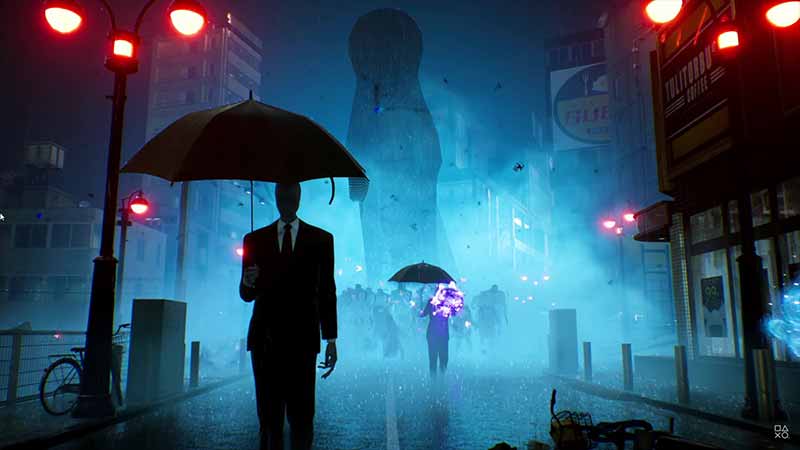Since its official announcement trailer back at E3 2019, Ghostwire: Tokyo has caught the attention of gamers worldwide with really amazing graphics and breathtaking reflections. And once Sony confirmed the game (games is PS exclusive on consoles) will be utilizing the full raw power of the PS5 console, many wanted to know how the game would look on a high-end PC with full graphics options enabled. Today we will share our opinions on both NVIDIA RTX & DLSS performance in our Ghostwire: Tokyo PC Review.
Ghostwire Tokyo NVIDIA RTX & DLSS Review

I was both surprised and kind of happy when the devs Tango Gameworks announced that Ghostwire Tokyo will be running on Unreal Engine 4, unlike their previous Evil Within games which ran on id Tech 5 engine. The Evil Within 2 used a custom id Tech engine called STEM engine, still, it was id Tech in its roots. Unreal Engine 4 was supposed to open lots of new opportunities for the devs. And with PS5 showcasing Unreal Engine 5 performance, the fans were intrigued with the idea.
But now the game is finally here, I could unarguably say that it looks really amazing. I tested the game both on my PS5 and PC with different graphics options. And not to make you wait till the end, a good PC can bring out the best Ghostwire Tokyo can offer.
The highlight is raytraced reflections. Everywhere you look you are sure to find some kind of reflection in it. And being a game taking place mostly in the rainy nighttime of city light-filled Tokyo, it’s amazing to walk through the streets. Accompanying them are the Ray Traced shadows. But they don’t affect the look of the game a lot cause most of them are baked directly or are using shadow maps. Still, it’s a nice addition to see here.
How’s the Ray Tracing on an NVIDIA GPU?
The puddles of water, glass buildings, and wet surfaces all have the in0game reflective materials applied to them. Even there are semi-translucent objects around the map, like plastic umbrellas which successfully react with the light to a great extent. Yes, you can still play the game with backed reflection maps if you are all into the performance.
But the same can’t be said about the RT shadows. I felt like sticking with regular shadows was way better while comparing the performance I am taking for those few ones scattered here and there. And some of the RT shadows looked too sharp near light sources without any diffuse. The shadows are supposed to be indirectly proportional to the light sources, but here it looks like the game is lacking in this aspect. This could be fixed by the devs, but I don’t believe this would be on top of their list now.
But even with RayTracing at high and the DLSS option set to performance mode, you are not losing out on many framerates with better reflections. Combining both the tech is the key to the performance in this game. And we really appreciate the fps these NVIDIA cards are pushed out just a marginal difference when every single setting is turned high.
There are places like refractive surfaces of vehicle windshields where you can see RT materials are not applied. But the devs managed to blend them with RT surrounding so well that you may mistake them for being real raytraced surfaces due to the quality.
Ghostwire Tokyo System Requirements
Here’s the tweet from the devs stating the min and recommended specs for Ghostwire Tokyo:
https://twitter.com/playGhostwire/status/1506034609192005633
But instead of the 30 FPS mentioned in the tweet on the major NVIDIA GPUs, we are able to achieve 60 FPS and even uncapped up to more than 100 frames per second easily using DLSS technology. Let’s look at how many frames/sec you expect on your NVIDIA GPUs with the help of the below chart.
Ghostwire Tokyo Performance Analysis
We got a chance to test out the Dell G15 Gaming laptop. Our tests are still in process, so for the start, we can share a short performance analysis. We have a Dell G15 Ryzen 5 5600H Model. Coupled with 16GB RAM, RTX 3050 4GB, and 512 SSD. This system is a kind of decent model designed to pull out the best of gaming at medium settings. RTX 3050 4GB plays a big role in the overall performance boost. However, it is unfair to expect super high resolution in such a tight space. We played Far Cry, AC Valhalla, COD, God of War PC, and even Elden Ring on Dell G15. At low to medium settings, things were smooth on a dual monitor setup. Things went a little laggy at high settings. This was expected, as gaming laptops do struggle to have a powerful cooling solution, they can deliver performance but cannot maintain it for hours.
In our case were not expecting Dell G15 to run games like Elden Ring, but it was surprising. For Ghostwire Tokyo, we face no issues on medium settings. G15 throws good graphics on a secondary 32 inch 4K LG monitor. If you are in the process to get a mid-range gaming PC, and wondering if there is a way to get a portable solution, then try Dell G15 Ryzen 5 edition. We will be sharing many performance videos of this laptop in the coming time.
Dell G15 5515 Specs:
- AMD Ryzen 5 5600H
- 16 GB DDR4 2933Mhz RAM
- Nvidia RTX 3050 4GB GDDR6
- 512 SSD
- 15.6 Inch FHD 120Hz Anti-Glare Display
Thanks to Dell for providing us G15 Gaming laptop to add more power to our review.
Here are the real-world performance done by YouTube channel ElAnalistaDeBits. They have to spend lots of effort in making this video with different GPUs. So kindly check the original video we have attached to this article too. So with that said let’s check the fps performance of Ghostwire Tokyo on different GPUs with DLSS, FSR, & TSR:
| GeForce RTX 3080 | ||||
| Resolution | 4K | 4K | 4K | 4K |
| Settings | Ultra | Ultra | Ultra | Ultra |
| DLSS | Off | Quality | Balanced | Performance |
| RT | On | On | On | On |
| FPS | 19 | 37 | 43 | 56 |
| GeForce RTX 3080 | ||||
| Resolution | 4K | 4K | 4K | 4K |
| Settings | Ultra | Ultra | Ultra | Ultra |
| FSR | Off | Quality | Balanced | Performance |
| RT | On | On | On | On |
| FPS | 20 | 37 | 56 | 67 |
| GeForce RTX 3080 | ||||
| Resolution | 4K | 4K | 4K | 4K |
| Settings | Ultra | Ultra | Ultra | Ultra |
| TSR | Off | Quality | Balanced | Performance |
| RT | On | On | On | On |
| FPS | 19 | 27 | 45 | 56 |
| GeForce RTX 3070Ti | ||||
| Resolution | 4K | 4K | 4K | 4K |
| Settings | Ultra | Ultra | Ultra | Ultra |
| DLSS | Off | Quality | Balanced | Performance |
| RT | On | On | On | On |
| FPS | 16 | 39 | 45 | 72 |
| GeForce RTX 3070Ti | ||||
| Resolution | 4K | 4K | 4K | 4K |
| Settings | Ultra | Ultra | Ultra | Ultra |
| FSR | Off | Quality | Balanced | Performance |
| RT | On | On | On | On |
| FPS | 16 | 29 | 47 | 67 |
| GeForce RTX 3070Ti | ||||
| Resolution | 4K | 4K | 4K | 4K |
| Settings | Ultra | Ultra | Ultra | Ultra |
| TSR | Off | Quality | Balanced | Performance |
| RT | On | On | On | On |
| FPS | 16 | 29 | 42 | 53 |
| GeForce RTX 3060Ti | ||||
| Resolution | 1440p | 1440p | 1440p | 1440p |
| Settings | Ultra | Ultra | Ultra | Ultra |
| DLSS | Off | Quality | Balanced | Performance |
| RT | On | On | On | On |
| FPS | 30 | 51 | 67 | 82 |
| GeForce RTX 3060Ti | ||||
| Resolution | 1440p | 1440p | 1440p | 1440p |
| Settings | Ultra | Ultra | Ultra | Ultra |
| FSR | Off | Quality | Balanced | Performance |
| RT | On | On | On | On |
| FPS | 30 | 42 | 60 | 75 |
| GeForce RTX 3060Ti | ||||
| Resolution | 1440p | 1440p | 1440p | 1440p |
| Settings | Ultra | Ultra | Ultra | Ultra |
| TSR | Off | Quality | Balanced | Performance |
| RT | On | On | On | On |
| FPS | 30 | 41 | 61 | 69 |
| GeForce RTX 3050 | ||||
| Resolution | 1080p | 1080p | 1080p | 1080p |
| Settings | Ultra | Ultra | Ultra | Ultra |
| DLSS | Off | Quality | Balanced | Performance |
| RT | On | On | On | On |
| FPS | 29 | 51 | 62 | 72 |
| GeForce RTX 3050 | ||||
| Resolution | 1080p | 1080p | 1080p | 1080p |
| Settings | Ultra | Ultra | Ultra | Ultra |
| FSR | Off | Quality | Balanced | Performance |
| RT | On | On | On | On |
| FPS | 29 | 41 | 55 | 72 |
| GeForce RTX 3050 | ||||
| Resolution | 1080p | 1080p | 1080p | 1080p |
| Settings | Ultra | Ultra | Ultra | Ultra |
| TSR | Off | Quality | Balanced | Performance |
| RT | On | On | On | On |
| FPS | 27 | 36 | 52 | 64 |
The above FPS is taken from similar scenes of gameplay with RayTracing turned on. Even you can get higher framerates with RT off, if you have a capable NVIDIA card, we suggest you turn it on. The Ray Tracing is the main highlight of Ghostwire Tokyo as we mentioned above. Still here’s FPS with RT off for your reference:
| GeForce RTX 3080 | ||||
| Resolution | 4K | 4K | 4K | 4K |
| Settings | Ultra | Ultra | Ultra | Ultra |
| DLSS | Off | Quality | Balanced | Performance |
| RT | Off | Off | Off | Off |
| FPS | 49 | 79 | 92 | 108 |
| GeForce RTX 3080 | ||||
| Resolution | 4K | 4K | 4K | 4K |
| Settings | Ultra | Ultra | Ultra | Ultra |
| FSR | Off | Quality | Balanced | Performance |
| RT | Off | Off | Off | Off |
| FPS | 49 | 69 | 98 | 106 |
| GeForce RTX 3080 | ||||
| Resolution | 4K | 4K | 4K | 4K |
| Settings | Ultra | Ultra | Ultra | Ultra |
| TSR | Off | Quality | Balanced | Performance |
| RT | Off | Off | Off | Off |
| FPS | 49 | 65 | 87 | 98 |
| GeForce RTX 3070Ti | ||||
| Resolution | 4K | 4K | 4K | 4K |
| Settings | Ultra | Ultra | Ultra | Ultra |
| DLSS | Off | Quality | Balanced | Performance |
| RT | Off | Off | Off | Off |
| FPS | 56 | 85 | 91 | 103 |
| GeForce RTX 3070Ti | ||||
| Resolution | 4K | 4K | 4K | 4K |
| Settings | Ultra | Ultra | Ultra | Ultra |
| FSR | Off | Quality | Balanced | Performance |
| RT | Off | Off | Off | Off |
| FPS | 56 | 79 | 94 | 107 |
| GeForce RTX 3070Ti | ||||
| Resolution | 4K | 4K | 4K | 4K |
| Settings | Ultra | Ultra | Ultra | Ultra |
| TSR | Off | Quality | Balanced | Performance |
| RT | Off | Off | Off | Off |
| FPS | 63 | 72 | 89 | 101 |
| GeForce RTX 3060Ti | ||||
| Resolution | 1440p | 1440p | 1440p | 1440p |
| Settings | Ultra | Ultra | Ultra | Ultra |
| DLSS | Off | Quality | Balanced | Performance |
| RT | Off | Off | Off | Off |
| FPS | 83 | 105 | 105 | 110 |
| GeForce RTX 3060Ti | ||||
| Resolution | 1440p | 1440p | 1440p | 1440p |
| Settings | Ultra | Ultra | Ultra | Ultra |
| FSR | Off | Quality | Balanced | Performance |
| RT | Off | Off | Off | Off |
| FPS | 92 | 104 | 103 | 104 |
| GeForce RTX 3060Ti | ||||
| Resolution | 1440p | 1440p | 1440p | 1440p |
| Settings | Ultra | Ultra | Ultra | Ultra |
| TSR | Off | Quality | Balanced | Performance |
| RT | Off | Off | Off | Off |
| FPS | 86 | 98 | 97 | 101 |
| GeForce RTX 3050 | ||||
| Resolution | 1080p | 1080p | 1080p | 1080p |
| Settings | Ultra | Ultra | Ultra | Ultra |
| DLSS | Off | Quality | Balanced | Performance |
| RT | Off | Off | Off | Off |
| FPS | 52 | 74 | 82 | 98 |
| GeForce RTX 3050 | ||||
| Resolution | 1080p | 1080p | 1080p | 1080p |
| Settings | Ultra | Ultra | Ultra | Ultra |
| FSR | Off | Quality | Balanced | Performance |
| RT | Off | Off | Off | Off |
| FPS | 47 | 66 | 94 | 94 |
| GeForce RTX 3050 | ||||
| Resolution | 1080p | 1080p | 1080p | 1080p |
| Settings | Ultra | Ultra | Ultra | Ultra |
| TSR | Off | Quality | Balanced | Performance |
| RT | Off | Off | Off | Off |
| FPS | 47 | 58 | 71 | 83 |
Verdict
Even though you may see some extra frames sometimes in the same GPU while using TSR or FSR, compared to DLSS, there are many downsides to it. TSR is a technology developed for Unreal Engine 5 games, but GWT is a UE4 game. So both TSR and FSR lack many aspects the AI technology of DLSS can output. RT reflection looks smudgy, and long-distance objects in 4k clearly show a lack of details on the edges. Even the hair on the character in cutscenes shows the difference when compared to the fast render speeds of DLSS, which the other two lack. So DLSS is the winner here.
Now moving towards Ray Tracing, RT shadows are not worth spending your GPU resources in. The in-game shadow maps do more than enough job to make things look clear, and RT shadow materials are not that much abundant in the game world too. This is definitely a setting you can skip on. But RT reflection on the other hand changes the entire feel of the game. Nothing else adds as much realism as having an NVIDIA RTX card in your system with RT turned on.


